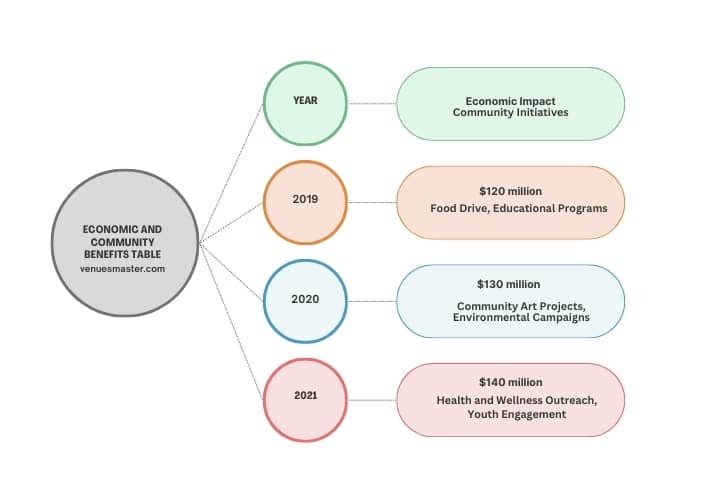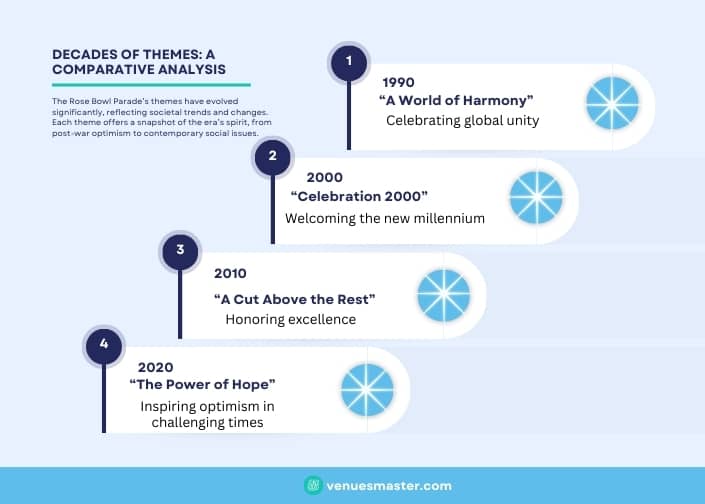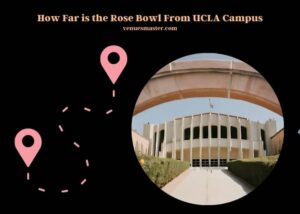Published on: 30 December 2023
Written by Najrul / Fact-checked by Asma Abir
The Rose Bowl Parade is an annual event held in Pasadena, California, celebrated for its stunning floral floats, marching bands, and equestrian units. It precedes the Rose Bowl college football game on New Year’s Day and is a cherished New Year’s tradition.
Originating in 1890, the parade has grown from a small community event into an internationally renowned spectacle, drawing hundreds of thousands of spectators each year. The floats, which are the parade’s hallmark, are engineering marvels adorned with flowers and natural materials, showcasing themes that range from whimsical to socially relevant.
The parade also serves as a stage for high school and college marching bands from across the nation, offering them a prestigious platform to display their musical talents.

Beyond entertainment, the Rose Bowl Parade has a significant impact on the local community and economy. It fosters community involvement through volunteer opportunities in float decoration and organization. The event also brings substantial economic benefits to Pasadena, with increased business for local hotels, restaurants, and shops.
The parade has evolved to include environmental sustainability in its practices, reflecting a commitment to eco-friendly initiatives. This blend of tradition, community, and innovation makes the Rose Bowl Parade a unique and enduring symbol of the New Year.
Journey Through Time: The Rose Bowl Parade’s History
The Rose Bowl Parade, a spectacle of flowers, music, and community spirit, began on January 1, 1890, as a promotional effort by Pasadena’s Valley Hunt Club. Initially, it featured chariot races, jousting, and foot races.
The parade’s focus shifted to floats adorned with flowers, celebrating California’s mild winter. This transformation marked the parade’s evolution into a globally recognized event, symbolizing innovation and community celebration.
Over the years, the parade has grown in scale and grandeur, reflecting both local and global cultural shifts. Key milestones include the introduction of motorized floats in the early 20th century, the integration of technological advancements, and the parade’s cancellation only during wartime. The Rose Bowl Parade has become a mirror of societal changes, showcasing themes ranging from patriotism during World Wars to cultural inclusivity in recent years.
Crafting the Spectacle: Behind the Scenes
Months before the Rose Bowl Parade dazzles spectators, a meticulous planning process unfolds. This involves designing floats that not only captivate visually but also withstand the parade route. Teams of skilled artisans, engineers, and volunteers collaborate to bring these designs to life, often working tirelessly to meet tight deadlines.
Volunteer involvement is a cornerstone of the parade, with thousands contributing countless hours to float construction and decoration. The logistics of coordinating such a large-scale event are formidable, encompassing route planning, crowd management, and ensuring safety standards. This behind-the-scenes effort is crucial in creating the seamless and spectacular experience that viewers enjoy each year.
Cultural Icon: The Parade in Popular Media
The Rose Bowl Parade’s influence extends far beyond Pasadena, embedding itself into popular culture. Its live broadcast reaches millions worldwide, making it a New Year’s Day tradition for many. The parade has attracted a range of celebrities and public figures as grand marshals, from entertainers to astronauts, adding to its allure.
Its representation in media, including films and television shows, further cements its status as a cultural icon. The parade’s influence is also evident in its impact on other parades and events, inspiring similar celebrations globally. This widespread media coverage and representation have made the Rose Bowl Parade a symbol of celebration and unity.
Community and Economic Impact
The Rose Bowl Parade significantly benefits Pasadena and its surrounding communities. It boosts local businesses, from hospitality to retail, contributing to the area’s economic vitality. The event also fosters community engagement, with local organizations and schools often participating in parade activities.
Charitable activities associated with the parade, such as food drives and community service projects, underscore its commitment to social responsibility.
Recent years have seen a growing focus on environmental sustainability, with efforts to minimize the parade’s ecological footprint.
Economic and Community Benefits Table
The Rose Bowl Parade is not just a celebration of culture and creativity; it’s a significant economic engine for Pasadena and its neighboring areas. The event’s impact extends beyond the immediate spectacle, contributing substantially to the local economy and community welfare.
Economic and Community Benefits Table
| Year | Economic Impact | Community Initiatives |
| 2019 | $120 million | Food Drive, Educational Programs |
| 2020 | $130 million | Community Art Projects, Environmental Campaigns |
| 2021 | $140 million | Health and Wellness Outreach, Youth Engagement |

Economic Impact: The table above illustrates the parade’s growing economic contribution over recent years. The influx of visitors for the event leads to increased spending in local businesses, including hotels, restaurants, and retail stores. This surge in economic activity provides a significant boost to the local economy, with the impact felt across various sectors.
Community Initiatives: Alongside its economic benefits, the Rose Bowl Parade plays a pivotal role in community development and social responsibility. Each year, the parade organizers and participants engage in various initiatives aimed at improving community welfare.
These range from food drives to support the needy, educational programs to engage local students, art projects that foster community creativity, environmental campaigns to promote sustainability, and health and wellness outreach programs. These initiatives demonstrate the parade’s commitment to not only entertain but also to give back and enrich the local community.
The data clearly shows that the Rose Bowl Parade is more than just an annual event; it’s a catalyst for economic growth and a beacon of community engagement and development.
Decades of Themes: A Comparative Analysis
The Rose Bowl Parade’s themes have evolved significantly, reflecting societal trends and changes. Each theme offers a snapshot of the era’s spirit, from post-war optimism to contemporary social issues.
Parade Themes Over the Years
| Year | Theme | Description |
| 1990 | “A World of Harmony” | Celebrating global unity |
| 2000 | “Celebration 2000” | Welcoming the new millennium |
| 2010 | “A Cut Above the Rest” | Honoring excellence |
| 2020 | “The Power of Hope” | Inspiring optimism in challenging times |

These themes not only highlight the parade’s adaptability but also its role in echoing public sentiment and aspirations.
FAQs
What Are the Parade’s Environmental Initiatives?
The Rose Bowl Parade has increasingly focused on environmental sustainability. Efforts include using eco-friendly materials for float construction and minimizing waste through recycling programs. The parade also encourages the use of natural, locally sourced flowers and materials to reduce the carbon footprint.
These initiatives reflect a growing awareness and responsibility towards environmental conservation, making the parade not just a cultural event but also a platform for promoting sustainability.
How Does the Parade Influence Local Education?
The parade’s influence on local education is profound. Schools in Pasadena and surrounding areas often incorporate parade-themed projects into their curriculum, fostering creativity and community involvement among students. These projects range from art and design to environmental studies, using the parade as a practical example.
The parade offers educational outreach programs and scholarships, providing students with unique learning opportunities and encouraging their participation in community events.
Who is responsible for putting on the Rose Bowl Parade?
The Tournament of Roses Association is responsible for putting on the Rose Bowl Parade. As the owner of the “rose bowl ownership,” they have been organizing the annual event since 1890, bringing together intricate floats, marching bands, and equestrian units to showcase to millions of spectators worldwide.
What is the significance of the Rose Bowl Parade’s location and legacy?
The Rose Bowl Parade’s location and legacy hold immense significance in its history. The rose bowl venue details, such as its iconic setting in Pasadena and status as one of the oldest college football stadiums in the country, contribute to the parade’s prestige and cultural impact.
What Role Do Technology and Innovation Play?
Technology and innovation play a crucial role in modernizing the Rose Bowl Parade. Advances in float design include the use of sophisticated hydraulics, computer-controlled animation, and LED lighting. These technological enhancements not only add to the visual spectacle but also improve safety and efficiency in float construction and operation.
The parade also embraces digital platforms for broader audience engagement, including live streaming and social media interaction, making it accessible to a global audience.
How Does the Parade Engage International Communities?
The Rose Bowl Parade has a significant international appeal, attracting participants and viewers from around the globe. It features international marching bands and performance groups, showcasing global cultures and fostering international goodwill.
The parade’s broadcast reaches millions worldwide, creating a global community of viewers who share in the celebration. This international engagement highlights the parade’s role in promoting cultural exchange and global unity.
What Are the Parade’s Future Prospects and Challenges?
Looking ahead, the Rose Bowl Parade faces challenges such as adapting to changing social norms and environmental concerns. Future prospects involve innovating while maintaining traditions, attracting younger audiences, and enhancing its global appeal.
The parade must balance the preservation of its historical essence with the need to stay relevant and engaging in a rapidly evolving world. Addressing these challenges is key to ensuring the parade’s continued success and legacy.
How Does the Parade Impact Local Infrastructure?
The parade’s impact on local infrastructure is significant, requiring extensive planning and coordination. Road closures, traffic management, and public transportation adjustments are essential to accommodate the parade route and spectators.
Local authorities and organizations work closely to ensure minimal disruption while providing safe and efficient access to the event. This coordination demonstrates the parade’s substantial influence on the city’s infrastructure and the collaborative effort required to host such a large-scale event.
Summary
The Rose Bowl Parade stands as a testament to tradition, innovation, and community spirit. From its humble beginnings to its current status as a cultural icon, the parade has continually adapted, reflecting societal changes and inspiring millions. Its economic and community impact, coupled with its thematic evolution, underscore its enduring relevance and significance.




